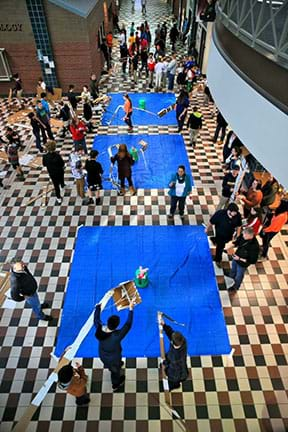Toxic Island: Design Devices to Deliver Goods
 TeachEngineering Toxic Island Maker Challenge contributed by the Research Experience for Teachers Program, Central Michigan University.
TeachEngineering Toxic Island Maker Challenge contributed by the Research Experience for Teachers Program, Central Michigan University.
Grade level: Middle School [Grades 6-8]
Time: 1 hour 45 minutes (wild guess)
Summary
A classic engineering challenge involves designing and building devices that can deliver necessary goods to “Toxic Island,” an island that has been quarantined by the World Health Organization due to a nasty outbreak of disease. Working within specific constraints, including limited materials, students follow the engineering design process to design, test, and improve a device that can deliver “medicine” and other vital supplies accurately and quickly without touching either the water or island.
Learning objectives
Learning standards
Next Generation Science Standards
- MS-ETS1-1. Define the criteria and constraints of a design problem with sufficient precision to ensure a successful solution, taking into account relevant scientific principles and potential impacts on people and the natural environment that may limit possible solutions. [Grades 6 – 8]
- MS-ETS1-2. Evaluate competing design solutions using a systematic process to determine how well they meet the criteria and constraints of the problem. [Grades 6 – 8]
International Technology and Engineering Education Association
- Test and evaluate the design in relation to pre-established requirements, such as criteria and constraints, and refine as needed. [Grades 6 – 8]
Materials & Supplies
- notebooks
- stopwatch or timer
- assortment of building supplies such as large sheets of cardboard, Styrofoam, aluminum foil, paper, saran wrap, plastic bottles, cardboard, construction paper, straws, bubble wrap, rubber bands, string, paper or binder clips, mouse traps, clothes and safety pin, popsicle sticks, spoons, cups, paper plates, and yard sticks
- assortment of adhesives and cutting tools such as stapler, duct tape, white glue, cement glue, hot glue, tape, box cutter, and scissors
- blue tarp, 3.7 m x 3.7 m (12 ft. x 12 ft.) to represent the ocean
- plastic pail, 9 L (~5 gallons), to represent the island
- box of “supplies” to be delivered to the island; this can be a toy or stuffed animal, or a box decorated like a supply delivery
Worksheets and Attachments
Middle School Lesson
Kickoff
Show slide 1 of the Maker Challenge PowerPoint. [PDF version].Today we will be practicing our critical thinking skills using the Engineering Design Process to solve a specific problem. Here is your task: the World Health Organization has quarantined an island nation due to an outbreak of a nasty virus. You must deliver necessary medical goods, food, (and chocolate!) to the Toxic Island’s ill inhabitants with the following constraints:
- You cannot touch the water or the island; it will contaminate any device immediately.
- The medicine is very rare and expensive, so accuracy is imperative!
- The people of the island need their supplies delivered quickly. Each team will have two minutes to deliver two loads of care packages consecutively (back-to-back).
Procedure/Maker Time
- Review the hypothetical situation, the deliverables, available materials, constraints, and steps of the engineering design process with the class.
- Break the class up into teams.
- Give each team 10 to 15 minutes to discuss and plan their delivery system. Students should brainstorm ideas on paper and cite the dimensions and materials of their design. To use a material, students must cite its use in their design in some way. Roam the room and ask the students to show off their plans and designs. (If you see a design that you know will fail, do not say anything.)
- Once the teams decide on one design, assess the design. If approved, students may go on to select their materials.
- Give the teams 15 to 20 minutes to build their prototypes.
- Allow students to test their designs with the blue tarp, pail, and deliverables. Give the teams two minutes to deliver their care packages consecutively (back-to-back). This will demonstrate that their design can consistently deliver the supplies.
- Give the teams an additional 10 to 15 minutes to iterate on their design.
- Allow students to retest their designs.
- Have each team present how their design works and discuss any challenges or pitfalls they discovered in the design process.
Wrap Up
Have students take out a piece of paper and answer the following questions:
- How could you improve your device to be more accurate?
- How many times in a row can you successfully deliver the package?
- Are there ways you could improve the design to make it more accurate?
Tips
If you see a design that you know will fail, do not say anything! An important aspect of the engineering design process is learning from failure. If (or when) a device fails, have the students determine why it failed and then have them iterate on their design and retest it.
Contributors
Ron Ratkos; Matt Barco; William Gustin; David Proctor; Holly Ylitalo; Jennifer Bole; Christopher Cole; Andy Frisch; Caleb Wagar; Allison Abram; Will Falkner; Emily Miller; Brad Parsons; Alexandra Wagner; Beth Christiansen
Copyright
© 2019 by Regents of the University of Colorado; original © 2018 Central Michigan University
Acknowledgements
This curriculum was based upon work supported by the National Science Foundation under RET grant no. EEC 1542368— Research Experience for Teachers through Central Michigan University. Any opinions, findings, and conclusions or recommendations expressed in this material are those of the authors and do not necessarily reflect the views of the National Science Foundation.
Thanks to Dr. Kumar Yelamarthi, Project Coordinator, and Julie Cunningham, Co-Project Coordinator
Filed under: Class Activities, Grades 9-12, Grades 9-12, Lesson Plans
Tags: Biomedical Engineering, Class Activities, commerce, delivery, Design, engineering design challenge, Engineering Design Process, Grades 9-12, Lesson Plan, maker challenges, pandemic, public health










